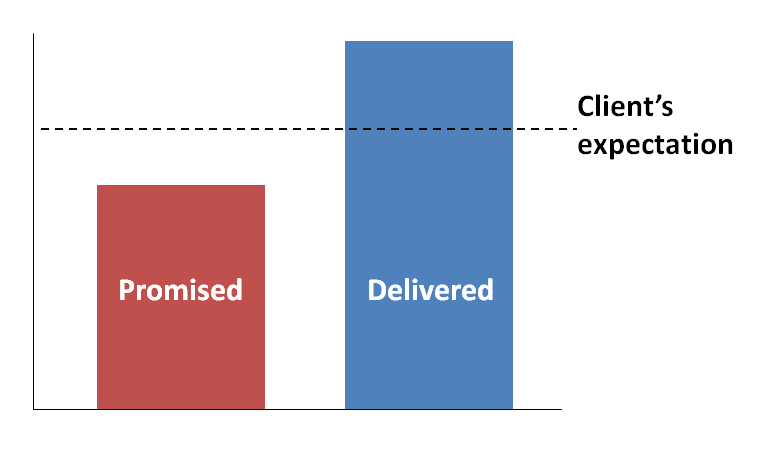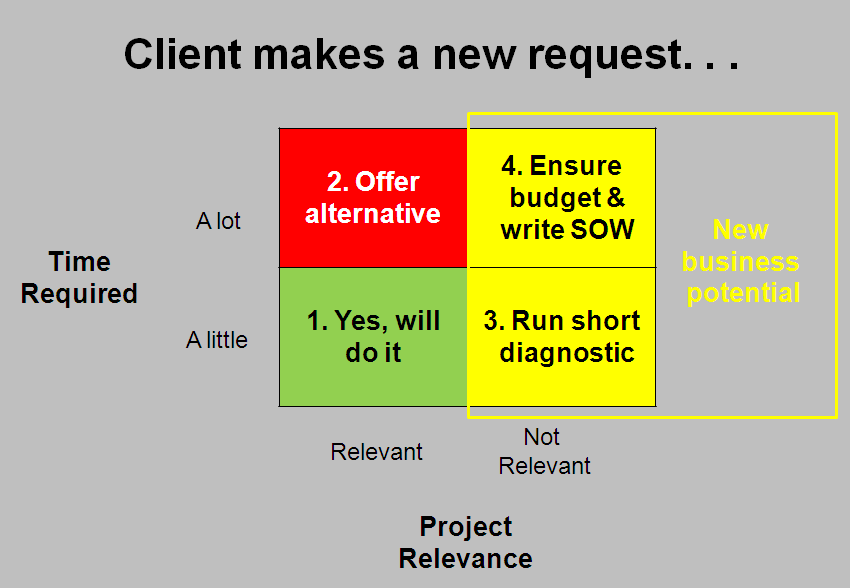It’s easy to say YES
When the client asks for something – new research, some ad-hoc analysis, an extra workshop – it usually seems like a reasonable request. After all, they pay the bills and shouldn’t they get the most out of their consultants?
When the consultant says YES to a new request, it may feel comfortable and collaborative. The consultant feels like she is doing a good job listening, and the client is happy that his idea was accepted. There is no stress, or pregnant pauses. It is the path of least resistance like water running downhill.
Experienced consultants and lawyers will tell you there are many reasons why being overly agreeable can create problems. Here are four of them:
1. False promise
It is easy to say YES in the heat of the moment, then completely forget about it. It is the equivalent to a husband telling his wife “sure, honey”, when he was not listening (and definitely not writing things down).
2. Over promise
It’s a crude graph, but it visualizes what all consultants know to be true: “under-promise, and over-deliver”. When the client asks for 100, promise less (red bar) and deliver more (blue bar). Sad, but true. By lowering client expectations, we have a better chance of exceeding. Call it cynical, call it sandbagging, but it works.
 3. Waste of time
3. Waste of time
Don’t get me wrong. Clients often give good feedback – especially when explaining the organizational context (read: politics). I have learned something from every client. That said, every client request is not valid. Sometimes, they are a waste of time. Remember: we are paid for our expertise and often paid by the hour. No reason to waste the client’s money, waste our time, or worse – put the project timing at risk.
4. Poor alignment
In my mind, this is the greatest danger. If the client keeps bringing up new ideas and ad-hoc requests. . . AND the consultant keeps agreeing to them . . . something is wrong. It is a symptom of a deeper problem:
Consultant issue
- The project plan is inadequate; key areas that were missing are getting dug up
- The right people were not involved in the beginning; new people keep popping up
- The consultant is doubting his own plan and looking for any life line
Client issue
- The client is not clear what the next steps or is uncomfortable with the timeline
- The analysis has not been robust or poorly explained; the client doubts the numbers
- The client has a pre-defined solution and wants the consultant to rubber stamp it
Thinking through the client’s request
So what is a good way to think about this problem? As you probably already know, consultants love 2×2 matrix. It distills the thinking into 2 variables, and forces you to think through the problem. Here is my take on the situation.

1. Say Yes:
If the request is minor and useful – don’t think twice – say yes and get it done. Professionally and quickly. Add value and move on. The client’s suggestion was helpful.
2. Look for alternatives:
If the request will take a lot of time and is relevant to the project, look for a simpler and more elegant solution. Ask questions and understand WHY the client has this new request. One time, I resolved a client’s concern simply by adding a short footnote at the bottom of a PowerPoint presentation.
3. Offer to look into it:
If the request is not relevant to the project, it can be a good opportunity to sell more work. Offer to explore the issue – perhaps run a bit of analysis, or do some research – nothing serious, just some sleuthing on the topic.
4. Sell more work:
Provided there is budget, this could easily be the easiest way to sell new work. It could be a blossoming client-consultant relationship where each project is followed by another one. Nothing sells work like doing good work.

It gets easier after time and after experience to not automatically say yes to every client wish.
When you’re new in the business and [weigh the] threat’s to escalate and make you personally ‘pay’; you’ll need some confidence that you might not have as a beginner.
Furthermore it depends always on the specific situation: if your client is high ranked and lives in an ‘yes is the only answer’ environment it can be quite fruitful and positive to say ‘No’ once directly.